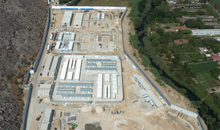
 Flash News
Flash News
Argument with hard objects at a residence in Lundë, one person is suspected of being injured
Pope Francis' funeral, 4,000 police officers will oversee security at the Vatican tomorrow
Video/ Disappointed miner burns his PS card
Accident in "Plepat e Kardhiqit", German hits pedestrian in Gjirokastra
He raped an OSHEE employee, a 38-year-old man is wanted in Tirana
Workers produced more in 2022 but were paid less, businesses hit record profits

Labor productivity, which measures the income received by an employee (business figure per employee), marked a significant increase during 2022 according to official data from INSTAT, which originate from the final data of the Structural Survey of Enterprises , recently published.
Net sales to hire for 2022 were 6.13 million ALL from 5.11 million ALL in 2021, increasing by 20%. INSTAT referred that this indicator is higher among producers of goods, compared to producers of services.
In 2022, business sales were helped by rising prices, while employee wage costs grew at a slower pace. According to INSTAT, the real salary increase (indexed for inflation) in 2022 was only 1.5%.
More detailed data show that in 12 regions of the country, in 9 of them salaries have increased less than inflation, affecting that the real salary in the vast majority of the country has decreased compared to 2021.
Businesses achieved record profits
In 2022, average inflation reached 6.7%, due to disruptions in the production chain caused by the pandemic and then the effects of Russia's attacks on Ukraine on commodity prices.
As the increase in business costs was transferred to the end consumer, enterprises have resulted in record profits. Other data from the Ministry of Finance revealed that income from profit tax reached a record of 47.7 billion ALL, increasing by 34% on an annual basis.
Even the annual ranking of the companies with the biggest profits, published by Monitor, showed a significant increase in profits.
The trend changed in 2023
But in 2023, the data points to a slowdown in labor productivity, as wages in both the private and public sectors saw rapid growth. Especially in the private sector, wage growth was driven by immigration, which caused labor shortages, forcing businesses to sacrifice profits.
The increase in the average salary in the private sector continued to remain in double digits during the third quarter of 2023. It marked the level of 14.5%, from 15.0% in the previous quarter.
In real terms, salary growth in the private sector stands at 10.4%, the same value as in the second quarter of 2023.
This increased unit labor costs by 9.9% during the third quarter of 2023, accelerating from the 7.1% rate recorded a quarter earlier. The performance has reduced labor productivity, the Bank of Albania analyzed in recent days.
Productivity fluctuations
Over the past decade, labor productivity fluctuated and often declined even as the economy was growing. Actions for the formalization of the economy increase the number of legal employees, who, although growing, had no way to influence production.
In Albania, employment increased more than economic growth, as a result, employees shared less earnings from work.
Demographic developments, with the aging of the population and the reduction of the labor force, are putting pressure on Albania's economic model.
Experts and international financial institutions call that Albania should increase teaching skills to orient the economy towards innovation and more productive sectors.
Analyzes by specialized institutions such as the IMF and the Bank of Albania show that increasing wages without increasing productivity in the economy turns into a risk, influencing the increase in prices and not welfare.
The practices of other countries have shown that labor productivity increases by orienting the economy to technology, innovation and products and services that have a high value in the market.
But to reach this stage, the country needs a well-educated and skilled workforce./ Monitor
Latest news




The young man who was injured today in Farka is the son of the former DP MP
2025-04-25 21:52:26


Andres Pastrana: CDI stands strongly by the DP, has shown determination
2025-04-25 20:57:42






Berisha in Tirana: Benefits and subsidies for those returning to Albania
2025-04-25 19:32:44
Berisha: Albanians spend 4 times more on medicine than on bread
2025-04-25 19:19:58
Russia and Iran strengthen ties with gas deal
2025-04-25 19:02:46
Video/ Disappointed miner burns his PS card
2025-04-25 18:45:02
Accident in "Plepat e Kardhiqit", German hits pedestrian in Gjirokastra
2025-04-25 18:36:02
Begaj and Osmani pay homage near the body of Pope Francis in the Vatican
2025-04-25 18:17:28
He raped an OSHEE employee, a 38-year-old man is wanted in Tirana
2025-04-25 18:04:30



62-year-old man dies after falling from height while working in Golem
2025-04-25 17:15:29
Russian general killed in Moscow bomb blast
2025-04-25 16:58:28


Tirana/ Drunk 22-year-old breaks equipment, father and son punch her
2025-04-25 16:20:12



Meta: Pension increases will begin immediately with the vote for No. 1
2025-04-25 15:29:47
Trump: Crimea will stay with Russia, Zelenskyy knows this
2025-04-25 15:20:27
Silent deforestation from illegal logging, fires, mining and neglect
2025-04-25 15:11:12
New Moon challenges, opportunities for these two signs
2025-04-25 15:01:38
Accident on the Gjirokastër-Tepelena axis, German driver hits 38-year-old woman
2025-04-25 14:49:59
Improve eye health, 10 foods you should definitely add to your daily meals
2025-04-25 14:41:31
Tourism falters in March, foreigners fall by 2.7 percent
2025-04-25 14:31:59
Fiscal Peace in Albania: A Dangerous Deal with the Past
2025-04-25 14:24:48
Selling cannabis at Kombinat, 25-year-old arrested
2025-04-25 14:19:32

Rama's show with Vlora airport, will it end up abandoned like Kukësi?
2025-04-25 14:01:06

Arrested for stalking Dibra hospital director, house arrest for Irini Shehu
2025-04-25 13:41:48
Incidenti në Dibër, Berisha: Provokacion i ulët i bixhozgjiut Blendi Klosi
2025-04-25 13:32:40
Police officer arrested for driving ambulance while drunk in Vlora
2025-04-25 13:27:02

DP denounces the mayor of Maliq, Gëzim Topçiu, to SPAK
2025-04-25 12:55:50

Woman jumps from the eighth floor of the building in "Don Bosko"
2025-04-25 12:34:23

DP's program for medicine/ Alimehmeti: Healthcare needs urgent reforms
2025-04-25 12:20:11



Eni Vasili elected General Director of RTSH
2025-04-25 11:40:27


Serious accident in the Kalimash Tunnel, suspected victims
2025-04-25 11:05:23
Gjimnazisti vret shokun dhe plagos tre të tjerë
2025-04-25 10:59:57
Kosovo Assembly constitution fails again, VV candidate rejected
2025-04-25 10:42:29






Begaj leaves for Italy, will attend Pope Francis' funeral
2025-04-25 09:29:14
Farewell to Pope Francis, over 128 thousand believers in homage in 48 hours
2025-04-25 09:21:28
Asphalt campaign for votes in the villages of Mati
2025-04-25 08:59:25

Foreign exchange/ How much foreign currencies are bought and sold today
2025-04-25 08:40:05
Albania needs 20 years to be classified in the group of high-income countries
2025-04-25 08:35:33
Horoscope, what do the stars have in store for you today?
2025-04-25 08:21:37
What is the weather expected to be like today, the forecast for this Friday
2025-04-25 08:09:26
Posta e mëngjesit/ Me 2 rreshta: Çfarë pati rëndësi dje në Shqipëri
2025-04-25 07:53:43
"Rama waves his passport in vain", Noka: Our strong point is the program,
2025-04-24 22:56:22


Kryemadhi: I like going to SPAK, I make jokes
2025-04-24 22:21:02

Tirana/ The young man is brutally raped and taken hostage
2025-04-24 22:03:32



DW: Thousands of people at the "March of the Living" at Auschwitz
2025-04-24 21:19:06

A party that has always thought about Albania...
2025-04-24 20:52:51

Gjadri Camps, ANSA: EC Committee for the Prevention of Torture soon in Albania
2025-04-24 20:36:39


39 killed in latest Israeli attacks on Gaza
2025-04-24 19:57:02


US and OSCE representatives attend mass for Pope Francis at St. Paul's Cathedral
2025-04-24 19:08:45

The world's youngest billionaire! Who is Lucy Guo, founder of ScaleAI?
2025-04-24 18:53:51

